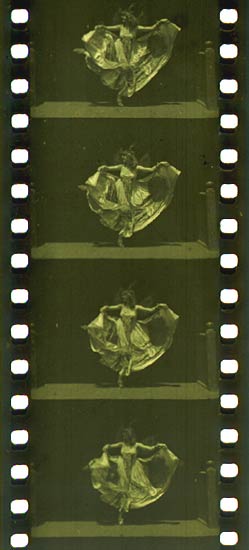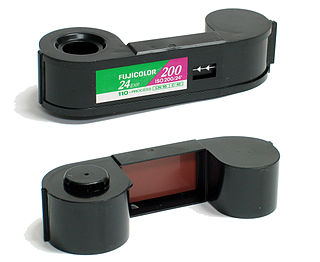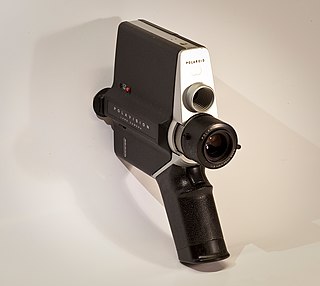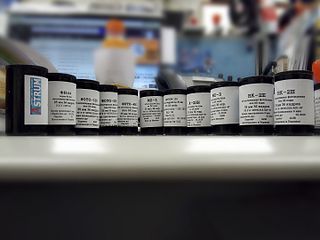
Film stock is an analog medium that is used for recording motion pictures or animation. It is recorded on by a movie camera, developed, edited, and projected onto a screen using a movie projector. It is a strip or sheet of transparent plastic film base coated on one side with a gelatin emulsion containing microscopically small light-sensitive silver halide crystals. The sizes and other characteristics of the crystals determine the sensitivity, contrast and resolution of the film. The emulsion will gradually darken if left exposed to light, but the process is too slow and incomplete to be of any practical use. Instead, a very short exposure to the image formed by a camera lens is used to produce only a very slight chemical change, proportional to the amount of light absorbed by each crystal. This creates an invisible latent image in the emulsion, which can be chemically developed into a visible photograph. In addition to visible light, all films are sensitive to X-rays and high-energy particles. Most are at least slightly sensitive to invisible ultraviolet (UV) light. Some special-purpose films are sensitive into the infrared (IR) region of the spectrum.

Keykode is an Eastman Kodak Company advancement on edge numbers, which are letters, numbers and symbols placed at regular intervals along the edge of 35 mm and 16 mm film to allow for frame-by-frame specific identification. It was introduced in 1990.

Super 8 mm film is a motion-picture film format released in 1965 by Eastman Kodak as an improvement over the older "Double" or "Regular" 8 mm home movie format.

Film speed is the measure of a photographic film's sensitivity to light, determined by sensitometry and measured on various numerical scales, the most recent being the ISO system introduced in 1974. A closely related system, also known as ISO, is used to describe the relationship between exposure and output image lightness in digital cameras. Prior to ISO, the most common systems were ASA in the United States and DIN in Europe.

110 is a cartridge-based film format used in still photography. It was introduced by Kodak in 1972. 110 is essentially a miniaturized version of Kodak's earlier 126 film format. Each frame is 13 mm × 17 mm, with one registration hole. Cartridges with 12, 20, or 24 frames are available on-line. Production variations sometimes have allowed for an additional image.

Single-8 is a motion picture film format introduced by Fujifilm of Japan in 1965 as an alternative to the Kodak Super 8 format. The company Konan claims in its history page to have developed the Single-8 system in 1959.

ORWO is a registered trademark of the company ORWO Net GmbH, based in Wolfen and is also traditionally known for black-and-white film products, made in Germany and sold under the ORWO brand.

Fujifilm Holdings Corporation, trading as Fujifilm, or simply Fuji, is a Japanese multinational conglomerate headquartered in Tokyo, Japan, operating in the areas of photography, optics, office and medical electronics, biotechnology, and chemicals.

In photography, reversal film or slide film is a type of photographic film that produces a positive image on a transparent base. Instead of negatives and prints, reversal film is processed to produce transparencies or diapositives. Reversal film is produced in various sizes, from 35 mm to roll film to 8×10 inch sheet film.
Color print film is used to produce color photographic prints, which date to the early 20th century. Initially a two-color process, it became three-color, more accurate, and more durable with the 1935 introduction of Eastman Kodak’s Company’s Kodachrome film, followed a year later Agfa Company’s Agfacolor. Color print film is the most common type of photographic film in consumer use. Print film produces a negative image when it is developed, requiring it to be reversed again when it is printed onto photographic paper.

FILM Ferrania s.r.l. is a photographic film manufacturing company located in Ferrania (Liguria), Italy. Ferrania was founded in 1923 as a maker of photographic film, papers, and photographic equipment, including cameras. The company was purchased in 1964 by the 3M company to become Ferrania 3M, until it was spun off in 1996 to 3M's Imation division. In 1999, Ferrania was acquired by Schroder Ventures and then spun off as a separate company. Subsequently, it was acquired by a Genoese shipping company, Gruppo Messina who ceased photographic activities in 2009.

Polavision was an "instant" color home movie system launched by Polaroid in 1977.

Tri-X is a black and white photographic film produced by the Eastman Kodak Company. Since 2013, it is distributed by Kodak Alaris which controls the Kodak Professional product line under which it is grouped. The combination of hand-held cameras and high-speed Tri-X film was transformative for photojournalism and for cinema.

Photographic film is a strip or sheet of transparent film base coated on one side with a gelatin emulsion containing microscopically small light-sensitive silver halide crystals. The sizes and other characteristics of the crystals determine the sensitivity, contrast, and resolution of the film. Film is typically segmented in frames, that give rise to separate photographs.

Tasma is a Russian GOST and ISO certified manufacturer of black-and-white and colour photographic films. It also manufactures adhesive tape and demineralized water. Located in Kazan, Russia, it has been in operation since 1933. The name Tasma is derived from the Russian phrase Татарские светочувствительные материалы, meaning "Tatar Sensitized Materials"; this name was adopted by the company in 1974.

Cinestill Film is a Los Angeles-based company selling photographic film for analog cameras in collaboration with Kodak motion picture cinema film stock. The two brothers who founded the company started as a small business shooting music and wedding photography, building and modifying cameras and lenses, then moved on to chemically adapting motion picture film so it could be processed at photo labs.

Astrum is a photographic supplies company located in Ukraine and established in 1995. It operates equipment once used by Svema to produce similar product lines.



















